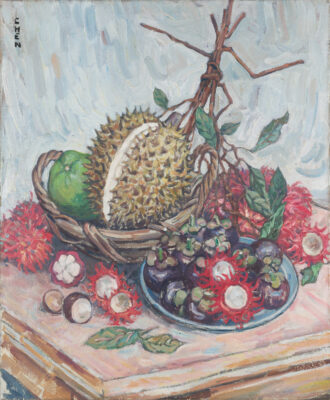Georgette Chen and Her Legacy: Shaping Modern Art in Singapore
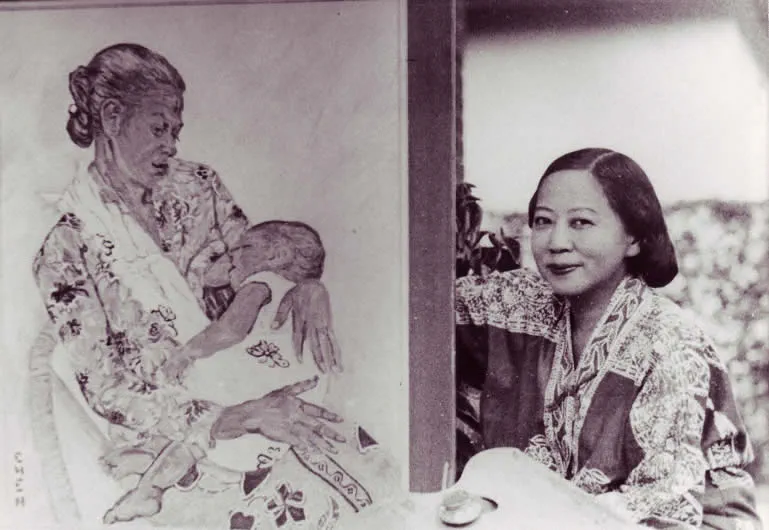
Georgette Chen, a pioneer of Singaporean modernism and the Nanyang style, fused Eastern subjects with Western technique to create vibrant still lifes and lyrical portraits. Her legacy lives on through her art — now celebrated globally and sought after by collectors.
Table of Contents
Georgette Chen, a trailblazer of Singapore’s Nanyang art style, is in the spotlight this season as Aurora & Athena features one of her works in the upcoming November 2025 Fine Art Auction.
Renowned for her vibrant still-life paintings and cultural legacy, Chen (1906–1993) was a modernist who bridged Eastern and Western art traditions (christies.com).
In the November 8, 2025 auction, Aurora & Athena is proud to present a highlight from this pioneering artist – a rare chance for collectors to acquire a piece of Singapore’s art history.
Chen’s story and creations not only shaped Southeast Asian art but today also command significant attention in the art market, with paintings by Georgette Chen increasingly coveted as her auction prices reach record heights (observer.com).
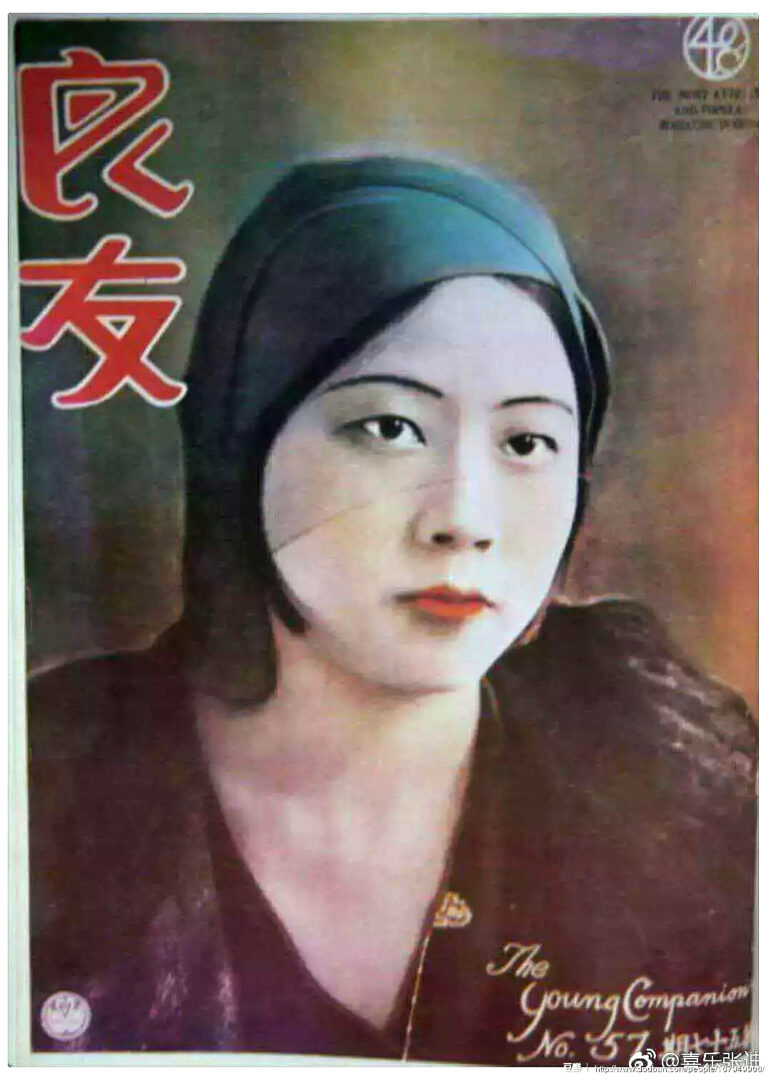
In this article, we explore Chen’s remarkable biography, her distinctive artistic style, notable works, and the market rise that has put her in headlines – all in anticipation of the auction debut of her work at Aurora & Athena.
Biography & Artistic Journey
Born Georgette Chen Liying on October 23, 1906, to a cosmopolitan Chinese-French family, Chen’s life journey was as global as her art. She grew up between China, Paris, and New York, her father being a wealthy antiques dealer and supporter of Sun Yat-sen’s revolution (en.wikipedia.org). This privileged upbringing exposed her early to art and cross-cultural influences. In the 1920s, Chen honed her craft in New York at the Art Students League and later in Paris at the Académie Colarossi, absorbing the currents of Impressionism and Post-Impressionism.
By 1930, at just 24, she achieved the rare feat of exhibiting at the Salon d’Automne in Paris – a noteworthy accomplishment for a young Asian woman artist (christies.com). That same year she married Eugene Chen, a Chinese diplomat (and former foreign minister under Sun Yat-sen), and moved to Shanghai (en.wikipedia.org).
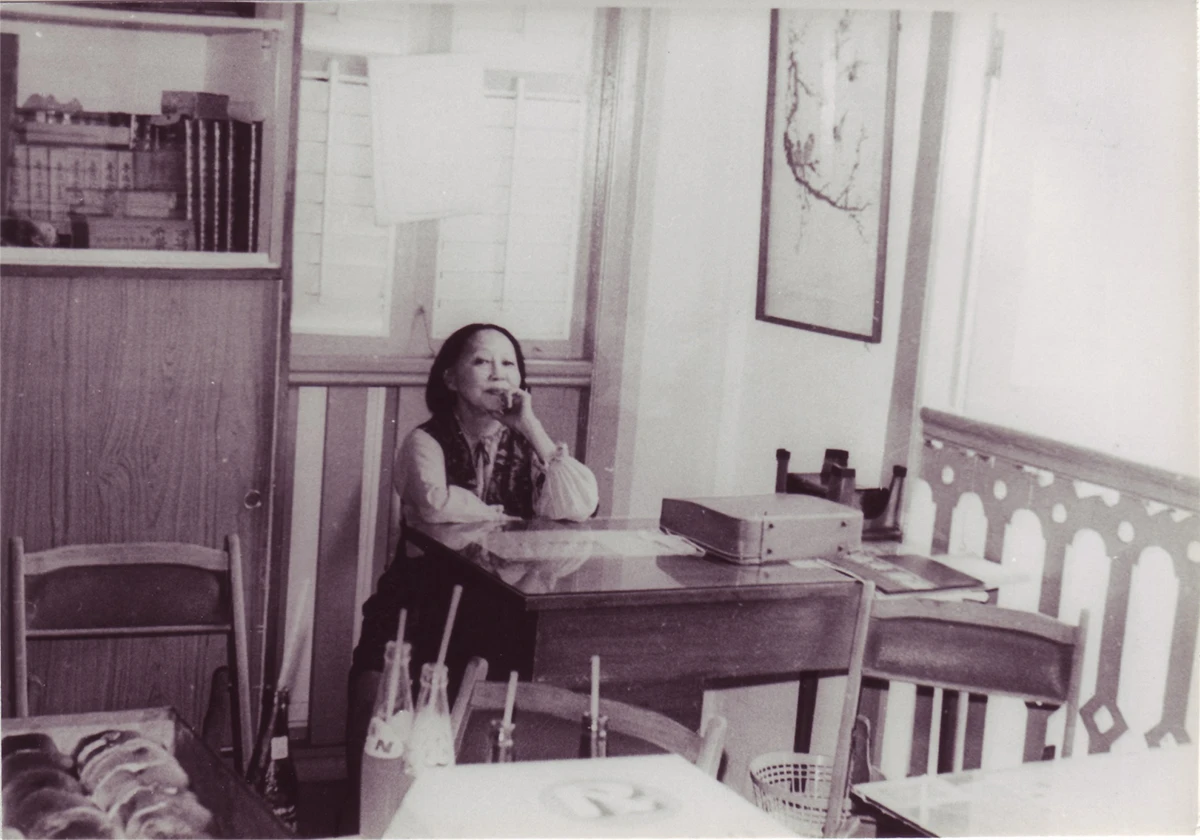
The upheavals of war marked the next chapter of her life. During World War II, Chen and her husband were in occupied Shanghai (and even placed under house arrest by the Japanese)(christies.com).
Eugene’s passing in 1944 and the end of the war prompted Georgette Chen to seek a new start in Southeast Asia. In 1951 she relocated to Penang, Malaya, and by 1953-54 settled permanently in Singapore, the place that would become her artistic home (christies.com).
There she joined the faculty of the Nanyang Academy of Fine Arts (NAFA) in 1954 and taught for decades, mentoring young artists. She embraced Singapore as her own – even adopting a Malay nickname “Chendana” – and became a naturalized citizen in 1966. Throughout her long career in Singapore, Chen emerged as a pioneer of modern Singaporean art and the Nanyang style, one of the rare female artists in a male-dominated art community.
Her contributions as both an artist and an educator were eventually recognized with the Cultural Medallion in 1982 (en.wikipedia.org), Singapore’s highest arts honor. By the time of her passing in 1993, Georgette Chen had firmly cemented her legacy as a founding figure of Southeast Asian modern art (en.wikipedia.org). Her life’s journey – spanning Paris salons and tropical Malayan landscapes – deeply informed the East-West synthesis that defines her work.
Artistic Style & Notable Works
Georgette Chen’s art is celebrated for its fusion of Eastern subjects with Western painting techniques, a hallmark of the Nanyang school she helped pioneer (christies.com). She is best known for her intimate still-life compositions of tropical fruits, as well as serene local scenes and portraits. In these works, one can discern her academic French training blended with her awe for Southeast Asian colors and culture (christies.com observer.com). Hallmarks of Chen’s style include immaculate brushwork, an elegant yet muted pastel color palette, and balanced compositions (christies.com). Critics often note the refinement and sophistication of her paintings – each piece exudes a sense of orderly beauty, yet remains lively and expressive in detail (christies.com).
One distinctive aspect of Chen’s still lifes is how she elevated everyday local produce into subjects of lyrical artistry. She once joked about being called a “rambutan specialist,” humbly crediting the “gorgeous ‘red heads’” (rambutans) rather than her own brush (christies.com).
Indeed, works like Sweet Rambutans (c.1965) and Tropical Fruits (1969) showcase her fascination with Southeast Asia’s bounty.
In Tropical Fruits, the largest known still life by Chen, she meticulously arranged rambutans, bananas, starfruit, and other fruits in baskets, even playfully suspending a bunch of red bananas from above – an experimental compositional twist (nationalgallery.sg).
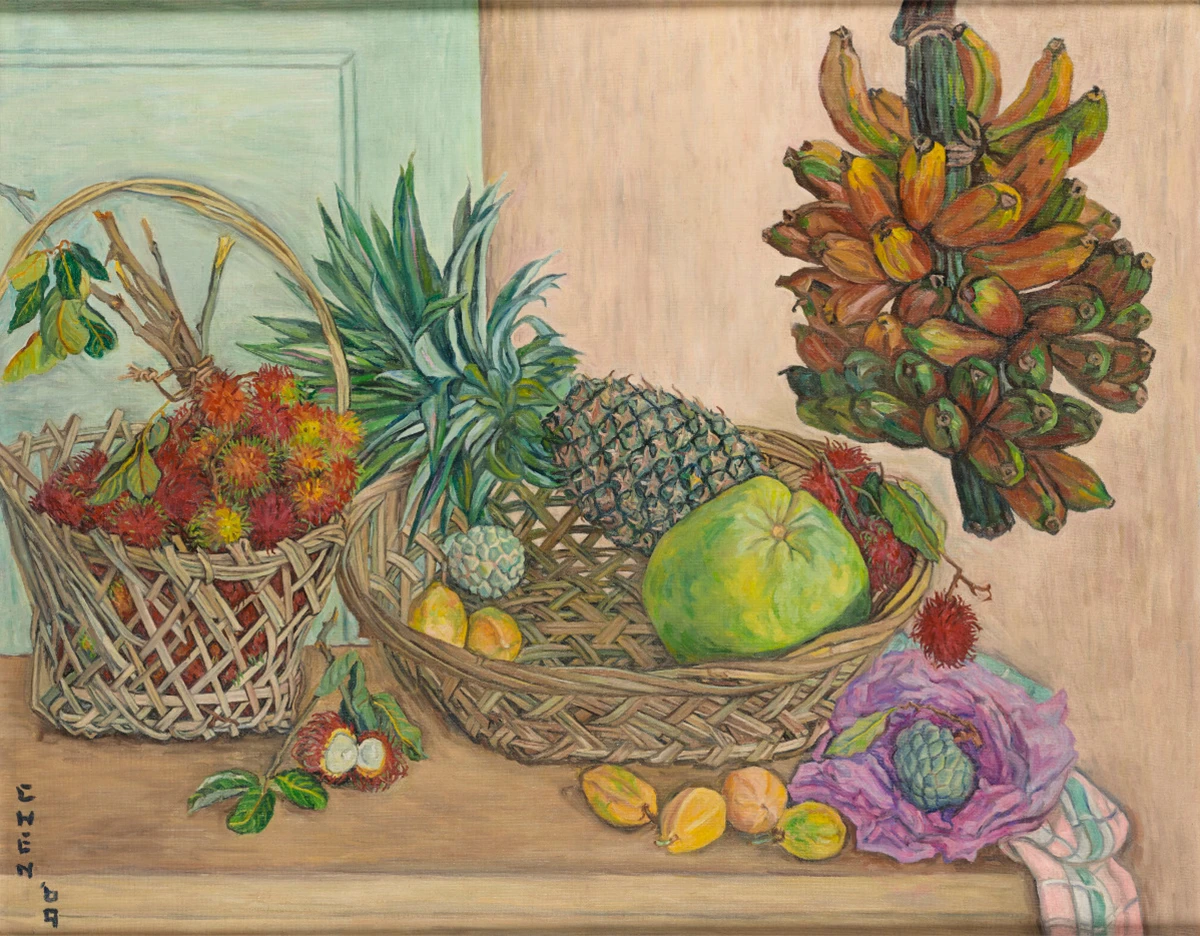
The painting’s careful balance of multiple viewpoints (a tilted basket revealing its contents, a side view of fruit on a table, etc.) was noted by curators as an innovation that reflects Cézanne’s influence on her approach (nationalgallery.sg). Chen’s backgrounds often feature gentle earth tones with touches of “dove blue,” a recurrent undertone in her canvases that offsets the warm reds and greens of her foreground subjects (christies.com). This creates a serene, dreamlike atmosphere, bringing a sense of calm to her vibrant scenes (christies.com).
Beyond still lifes, Georgette Chen also painted landscapes and portraits that are highly regarded. Her Malayan and Singaporean landscapes – such as scenes of Penang or the Singapore River – capture tropical light with a post-impressionist sensibility. Meanwhile, her portraits, like East Coast Vendor (1960) or Portrait of Madam Tan Hong Siang (1965), combine a keen observation of character with the same soft yet confident brushwork. Notably, Chen even painted herself; her Self-Portrait (c.1946) shows a stoic, dignified gaze amidst sepia tones, reflecting the poised resilience she maintained after the war (commons.wikimedia.org).
Throughout her oeuvre, whether depicting local fruit, village scenes, or friends and family, Chen achieved a unique harmony. As one analysis put it, “soft, curvilinear brushstrokes create waves of energy” in foliage and fruit, yet the overall impression is one of calmness and order, distinguishing her work from the turbulence of a Van Gogh even as she adopted some of his lively color and stroke techniques (christies.com). This balance of spontaneity and meticulous composition gave Georgette Chen’s paintings an “authenticity and measured refinement”, earning her a reputation as a true still-life poet of her time.
It is no wonder that exhibitions like Georgette Chen: At Home in the World (National Gallery Singapore, 2020) have drawn new appreciation to how her East-West artistic dialogue created a timeless, personal vision. Among her notable works often cited are Still Life with Cut Apple and Orange (1920s) – an early piece revealing her Cézanne influences – and later masterpieces like Fruits of Singapore (1975). Each canvas, whether of tropical fruit or a tranquil kampung scene, is immediately recognizable as a Georgette Chen: a fusion of Paris-trained technique with the soul of Southeast Asia.
Market Value & Auction Highlights
In recent years, Georgette Chen’s artwork has seen a surge in market demand, transforming her from a national art icon into a rising star at international auctions. For decades, her paintings were relatively under the radar in the global art market – for example, one of her still lifes fetched only around $36,000 the last time it appeared at auction in 1998 (observer.com). However, a wave of renewed interest, especially following retrospectives and a growing cohort of Asian collectors, has dramatically boosted Georgette Chen’s auction prices.
In the last few years alone, her price benchmarks have been shattered multiple times. In 2022, her oil Boats and Shophouses (c.1963-65), a charming street scene, sold for roughly $1.5 million in a Sotheby’s Singapore sale – setting a new record for any Singaporean artist at the time (observer.com). That record was swiftly surpassed: in November 2022, Still Life with Rambutans, Mangosteens and Pineapple (a classic Chen still life from the 1960s) achieved about $1.6 million, and then in May 2023 her Still Life with Big Durian went for a staggering $1.8 million at a Christie’s Hong Kong evening sale (observer.com).
This $1.8M sale made headlines as the highest price ever paid for a Singaporean painting at auction (christies.com). In less than a year, Chen’s auction record was broken three times, an extraordinary ascent for an artist who had never crossed the million-dollar mark before 2022 (observer.com),
Several factors explain this sharp rise. One is the rarity of her works on the market – many were held by family or donated to museums (over 100 of her paintings reside in the National Gallery Singapore and other institutions). When quality pieces do surface, collectors pounce on the opportunity. Another factor is the broader booming interest in Southeast Asian modernists. Collectors from Singapore, Malaysia, Greater China and beyond are actively seeking works by Nanyang pioneers like Chen as essential pieces of art history.
Additionally, exhibitions such as the 2020 retrospective At Home in the World rekindled public interest, and the entry of major auction houses back into Singapore (e.g. Sotheby’s held a high-profile sale in 2022) created buzz around local masterworks (observer.com). Evelyn Lin of Christie’s Asia noted “continued demand for the category” amid an influx of regional wealth, which has pushed top-tier Singaporean art to new heights (observer.com). Indeed, all of Georgette Chen’s top four auction results have occurred since 2022, each exceeding $1 million (observer.com).
For instance, Still Life with Big Durian not only topped Chen’s personal record but also underscored how far her market has come – from tropical fruit still lifes selling at modest sums domestically, to becoming trophy assets in international evening sales.
What makes Chen’s paintings so valuable to collectors today? Beyond their aesthetic beauty and historical importance, there is a sense of cultural pride and legacy attached to her works. She was a first-generation Singaporean artist who captured a formative era of the region’s identity on canvas. Owning a Georgette Chen piece means holding a vibrant slice of Southeast Asian art heritage, which resonates strongly with collectors in Singapore and the Asian diaspora.
Moreover, supply is extremely limited – Chen produced relatively selectively, and many works remain in public collections. As a result, when a fresh painting comes to market, bidders know it could be years before another appears. This scarcity, combined with the cross-cultural appeal of her art (her paintings feel at home in both Eastern and Western collections), has led to spirited bidding and rapidly climbing prices.
For example, Chen’s Boat and Street Scene (similar to Boats and Shophouses) was estimated around HK$5–7 million in a 2022 auction (≈US$740k–1M) (news.artnet.com), but the fervor of competition drove the final price well beyond the high estimate, hitting over S$2 million (straitstimes.com). Such results have firmly placed Georgette Chen in the ranks of blue-chip Southeast Asian artists. Art market analysts note that her work’s value has appreciated not just financially but also in recognition – collectors now view Georgette Chen’s paintings as crown jewels of Singapore’s art canon, worthy of museums and prestigious private collections alike (observer.com).
In short, the market trajectory for Chen’s art has been a revelation, transforming her from a local pioneer into an international auction star. And this momentum shows little sign of abating, as connoisseurs continue to pursue the rare opportunities to acquire her masterful works.
November 8 Auction Lot Spotlight
Georgette Chen’s Still Life with Rambutans (oil on canvas, 64.5 × 53.5 cm) is a quietly radiant example of her mature still-life work — a painting that encapsulates the spirit of Nanyang modernism through humble tropical subjects.
Composed with serene discipline, this lush yet controlled scene features durians, rambutans, and mangosteens — their sculptural volumes and tactile skins rendered with exquisite tonal sensitivity.
Each fruit rests with natural authority, yet together they form a visual rhythm that pulses with life.
Chen’s hallmark fusion of Eastern subject matter and Western oil technique is fully evident here.
The work balances Post-Impressionist color modeling with classical composition, each object positioned for optimal interplay of shadow, texture, and hue. Against a pale, flickering background — layered with cool strokes of dove grey and periwinkle — the crimson rambutans pop like bursts of sunlight on paper. The curved spikes of durian, the waxy violet sheen of mangosteen, and the scattered halved skins all reflect Chen’s observational intensity and technical control.
Executed likely in the 1960s, this still life radiates with the artistic clarity Chen developed during her most prolific Singaporean years. The brushwork is confident yet restrained, turning what might be a simple tabletop arrangement into a contemplative harmony of color and space. It reflects her interest not in realism per se, but in the emotional resonance of form — where tropical fruit becomes a symbol of transience and beauty.
Still Life with Rambutans is more than a decorative still life — it is a cultural expression, connecting Chen’s Parisian training with her embrace of Southeast Asian subject matter. The result is a uniquely regional modernism: informed by global aesthetics but deeply rooted in place. Through this piece, Chen creates a visual poetry of Malayan abundance, filtered through her quiet discipline and humanistic gaze.
This particular work is signed “CHEN” in the upper left and carries strong provenance. It was held in a private collection in Singapore before being acquired by a collector in Berlin in 2016. The canvas remains in good vintage condition with some visible craquelure, consistent with age and medium.
For collectors and art historians alike, Still Life with Rambutans offers a rare and intimate look at Georgette Chen’s mastery — not only as a painter of fruit, but as an architect of Southeast Asian identity on canvas. It stands as a bridge between geographies, histories, and artistic philosophies, and serves as a testament to her enduring legacy.
Past Sales and Aurora & Athena Context
While this November auction marks Georgette Chen’s first appearance with Aurora & Athena, it builds on the house’s growing engagement with Asian modern art. In previous auctions, Aurora & Athena has successfully introduced other Southeast Asian artists to our international audience. As mentioned, the March 2025 Fine Art Auction included a work by Cheong Soo Pieng – a fellow pioneer of the Nanyang style – which found a buyer and helped spark conversations among collectors (auroraathena.com). Additionally, our July 2025 auction featured works by regional artists such as Affandi and Nguyen Phan Chanh, underscoring a rising interest in 20th-century Asian paintings.
The strong results for those pieces encouraged Aurora & Athena to continue sourcing high-quality works from this genre. However, Georgette Chen’s work coming to auction is a particularly notable event. It is the first time we have the privilege to handle a painting by Chen, who is an artist of almost legendary status in Singapore. This first-time offering underlines the auction’s importance – it’s not every day that a new market comes into play for such a significant artist. For collectors who follow Aurora & Athena, the inclusion of Chen’s still life is a chance to diversify their collections with a key name from Singapore’s art history.
We anticipate that Chen’s painting will draw interest from both existing clients and new bidders, possibly from Singapore/Malaysia given her following there. Aurora & Athena’s team has actively reached out to our network to highlight this lot, noting its reasonable estimate relative to the prices achieved in the larger auction houses. There is a sense of excitement internally, as this auction might set a precedent for future offerings of Southeast Asian art in Europe through Aurora & Athena. Should Still Life with Rambutans perform well, it could pave the way for more Georgette Chen works or those of her contemporaries to appear in our sales down the line.
It’s also worth noting for context that while Aurora & Athena is newer to selling Chen’s work, we have established credibility with similar artists. Our March 2025 sale of Cheong Soo Pieng, for example, helped validate the market’s appetite, even if on a modest scale (that abstract painting achieved €5.5k, above its reserve). We have also handled works by Vietnam’s Le Thi Luu (which fetched a strong €180k in March 2025) and by Indian and Middle Eastern modernists. So, the November 2025 auction feels like a natural and exciting progression – bringing Georgette Chen into our curated selection and continuing Aurora & Athena’s mission to connect collectors with masterpieces across cultures.
For readers interested in exploring related content, our Aurora & Athena Journal has previously published insights on the Nanyang art movement and its figures. You might find it enriching to read our piece on Cheong Soo Pieng’s innovations (“Beyond Ink: Cheong Soo Pieng’s Experimental Approach to Art”) for a deeper understanding of the circle Georgette Chen was part of (auroraathena.com auroraathena.com).
Additionally, internal links like the March 2025 Fine Art Auction results page or the July 2025 Auction highlights provide context on how Southeast Asian art has been performing within Aurora & Athena’s auctions. These resources underscore that Georgette Chen’s entry is part of a broader narrative of bringing Eastern and Western art worlds together – something very much in spirit with Chen’s own life and art.
Conclusion
As the Aurora & Athena November 8, 2025 Fine Art Auction approaches, excitement continues to build around the inclusion of Georgette Chen’s work. More than 70 years after she first made her mark in Paris and later in Singapore, Georgette Chen’s legacy as a cultural bridge lives on through her vibrant canvases, which resonate as strongly today as ever. Her story – of a visionary artist who merged East and West in her art – speaks to a global audience and to a new generation of collectors discovering the richness of Nanyang art.
The upcoming auction provides a rare chance to become part of that story. To hold a painting by Georgette Chen is to hold a piece of art history: the colors of tropical fruits that she lovingly painted, the spirit of a newly independent Singapore she helped nurture, and the sophistication of a School of Paris alumna who never lost her Asian roots.
For serious art collectors and curious enthusiasts alike, Georgette Chen’s paintings offer both aesthetic delight and deep cultural significance. They are at once beautiful still lifes and windows into a bygone era of Southeast Asia. The robust auction prices in recent years affirm that the market, too, recognizes this special value – her works are not only treasured for their beauty but also for what they represent.
And yet, beyond the numbers and records, it is the timeless appeal of Chen’s art that endures. Standing in front of one of her paintings, you can almost feel the quiet of her studio, imagine the artist arranging mangosteens and orchids, bridging her memories of Paris with the sunlight of the Malay Peninsula.
Aurora & Athena warmly invites you to experience Georgette Chen’s world for yourself. Whether through visiting our exhibition preview or perusing the catalog online, take a moment to appreciate the mastery of this pioneer. And on the evening of November 8, as Still Life with Still Life with Rambutans goes under the hammer, we will witness a new chapter in Chen’s journey – one that extends her reach to new collections and continues to inspire.
In the grand tapestry of art history, Georgette Chen’s contributions remain brightly colored threads, and now, over a century since her birth, those threads are being woven ever more prominently into the global art market. Don’t miss the opportunity to acquire a work by this remarkable artist, as collectors have a chance this November to be part of Georgette Chen’s living legacy. The fruits of her vision await their next custodian, and with them, a lasting connection to a truly inimitable pioneer of modern art
